What is the EAS form for?
If you want to go to university and you need some help to get there due to a long-term disadvantage, such as English language difficulty and/or financial hardship, you can apply for Educational Access Schemes (EAS). If your Year 11 and/or Year 12 studies have been badly affected by difficult circumstances and affected your ATAR score, EAS can help you gain admission to university if your ATAR is below a course cut-off.
Can I apply?
You can apply if you are an Australian citizen, a New Zealand citizen or a permanent resident of Australia (includes a holder of an Australian permanent resident humanitarian visa).
You can apply if you have been disadvantaged in one or more of the categories below:
- Disrupted schooling
- Financial hardship
- Home environment and responsibilities
- English language difficulty
- Personal illness/disability
- Refugee status
- School environment.
You can only apply for EAS once you have applied for UAC (Universities Admissions Centre), which you can do here.
Where can I access the form?
You can access the EAS form here. There is also a EAS booklet that has all the information you need and a guide on how to apply, which you can access here.
How do I fill out the form?
The EAS booklet is a guide on how to fill out the form. On pages 12-21 it lists the different disadvantage codes and how to apply for them. For example, if English is your second language and you started school in Australia in Year 7, 8, 9, or 10, your disadvantage code would be L01B. You would need to fill out a statement on the form and provide 4 pieces of documentation.
I’ve provided a sample of how to fill out the form below, based on the information given in the booklet. For my example, I have completed the disadvantage codes F01A (financial hardship), L01B (English language difficulty) and R01A (Refugee status).
When is the form due?
You can apply for EAS until Wednesday 12 July 2017. The best time to submit your application is by 30 November 2016. Go to page 5 of the EAS booklet for key dates.
Where do I send the form?
Submit your EAS application and supporting documentation to UAC by post, or drop it off at UAC’s Customer Service Centre.
The address is 2/6 Parkview Dr, Sydney Olympic Park NSW 2127.
EXAMPLE FORM WITH INSTRUCTIONS
EAS Form Page 1:
 You will need to fill out every section on this page. For section 1, you will need to have your UAC number. For section 2, you will need to enter your disadvantage code/s. You can find information on the codes on pages 12-21 of the EAS booklet. For section 3 you need to select ‘yes’ or ‘no’ for if you are receiving Centrelink payments. If yes, enter your CRN, which is 9 numbers ending with a letter (example K). Important: Your CRN is different to your CAN. If you are unsure what your CRN is, you can log into your Centrelink account and it is on the top right corner of the page, or you can contact Centrelink . For section 4, you will need to read the information on the page, as well as page 5 of the EAS booklet before signing.
You will need to fill out every section on this page. For section 1, you will need to have your UAC number. For section 2, you will need to enter your disadvantage code/s. You can find information on the codes on pages 12-21 of the EAS booklet. For section 3 you need to select ‘yes’ or ‘no’ for if you are receiving Centrelink payments. If yes, enter your CRN, which is 9 numbers ending with a letter (example K). Important: Your CRN is different to your CAN. If you are unsure what your CRN is, you can log into your Centrelink account and it is on the top right corner of the page, or you can contact Centrelink . For section 4, you will need to read the information on the page, as well as page 5 of the EAS booklet before signing.
First example, F01A.
Booklet information (page 13):
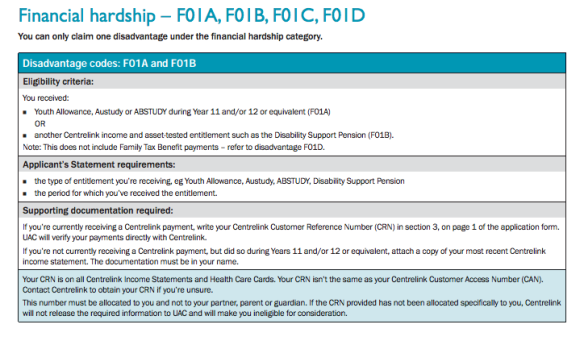
Form:

Supporting documentation: as you can see from the booklet, if you are currently on Centrelink, you only need to enter your CRN on page 1, section 3. If you used to receive Centrelink payments under your name in Year 11-12 and do not receive payments anymore, you will need to attach a copy of your last payment from Centrelink.
Educational Impact Statement (EIS): NOT REQUIRED FOR THIS CODE.
Second example, L01B.
Booklet information (page 18):
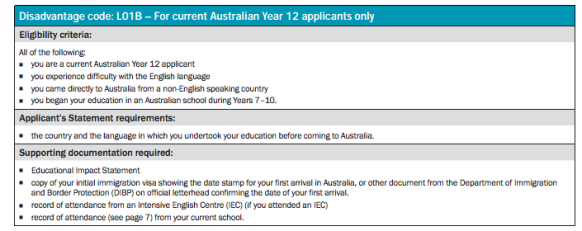
Supporting documentation: you will need to provide 1, 2 and 4. You will also need to provide 3 if you attended an Intensive English Centre (IEC).
- Educational Impact Statement.
- Copy of your initial immigration visa showing the date stamp for your first arrival in Australia OR other document from the Department of Immigration and Border Protection (DIBP) on official letterhead confirming the date of your first arrival.
- Record of attendance from an Intensive English Centre (IEC) (if you attended an IEC)
- Record of attendance (see page 7) from your current school.
Educational Impact Statement (EIS): On the section underneath your statement, you will need your a person from your school or a responsible person to fill out an EIS. They must complete this section, not you.
A person from your school includes your school/college principal, counsellor, year adviser or careers adviser.
A responsible person includes a doctor, lawyer, accountant, social worker, counsellor, religious or community leader who is familiar with your circumstances and who can provide information regarding your disadvantage and its effect on your ability to study. The person must not be a family member or friend.
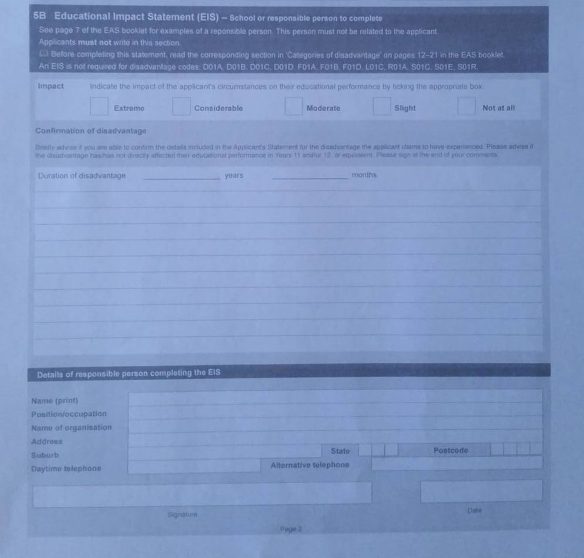
Third example, R01A.
Booklet information (page 19):
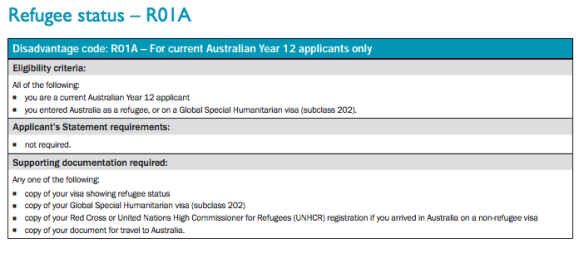
Form:
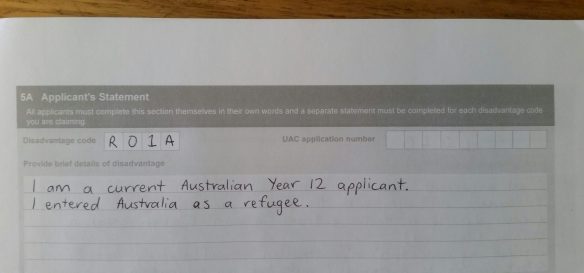
Supporting documentation: You only need to provide documentation for ONE of the following options:
- Copy of your visa showing refugee status
- Copy of your Global Special Humanitarian visa (subclass 202)
- Copy of your Red Cross or United Nations High Commissioner for Refugees (UNHCR) registration if you arrived in Australia on a non-refugee visa
- Copy of your document for travel to Australia
Educational Impact Statement (EIS): NOT REQUIRED FOR THIS CODE.
If you have any further questions, you can contact hsc4esl here, or email us at hsc4esl@gmail.com
Good luck!

